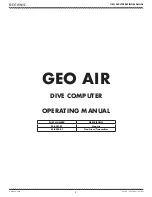
Maintenance and Troubleshooting
|
6-43
Filtration Stages
1. The first filtration stage is a coarse Membrane Filter, which is a thin
membrane with small pores. Gases will pass through the pores in the
membrane with only a small pressure drop. Liquid droplets will stay
on the upstream side because their surface tension is too high to allow
them to pass through the pores. This filter removes particulate and
high surface-tension liquids such as water, alcohols, glycols, and some
amines. Most of the low-surface tension liquids such as hydrocarbons
will also be eliminated. Since this membrane has a low surface area
and volume, the filter will not absorb volatile liquids. In contrast to the
membrane filter, a single-stage, coalescing filter can have problems,
because during upset conditions, these single stage filters become
saturated with volatile liquids and these liquids can only be evapo-
rated slowly over time.
2. The second filtration stage is another Membrane Filter, which has
smaller pores than the first stage. In this stage, small quantities of low
surface tension liquids, such as hydrocarbons, that are not extracted
by the first filter are removed. Most of the pressure drop through the
entire Filterblock Assembly occurs across the second filter stage.
3. The third and final filtration stage is a small Coalescing Filter, which
removes trace quantities of liquid aerosols as small as 0.1 microns.
Should the membranes in the first two stages become ruptured, this
stage will temporarily act as the main particulate and liquid filter.
Vent Flow
• The total vent flow in the Model 933S Analyzer is the sum of the flow
through the analyzer plus the flow from the drain Flow Restrictors in
the three filter stages.
• Maximum 20 NLM (42.4 SCFH) for the High Pressure/Low Range Kit.
• Combined flow through the three drain Flow Restrictors is roughly
proportional to the pressure at the filter inlet.
• Total flow from the three drain Flow Restrictors will increase by about
300 SCCM (0.3 L/min or 0.6 SCFH) for each 30 PSI (210 KPA) increase
in the inlet pressure. Typical values for this combined drain flow are:
- 1.0 L/min (2.12 SCFH) at 100 PSIG (700 KPAG) inlet pressure.
- 2.0 L/min (4.24 SCFH) at 500 PSIG (35000 KPAG) inlet pressure.
Summary of Contents for 933S
Page 24: ...1 8 Model 933S UV Analyzer This page intentionally left blank...
Page 34: ...2 10 Model 933S UV Analyzer...
Page 35: ...Specifications 2 11...
Page 36: ...2 12 Model 933S UV Analyzer 2016 12 16...
Page 37: ...Specifications 2 13...
Page 38: ...2 14 Model 933S UV Analyzer...
Page 39: ...Specifications 2 15...
Page 46: ...2 22 Model 933S UV Analyzer This page intentionally left blank...
Page 52: ...3 6 Model 933S UV Analyzer Figure 3 1 Analyzer backpan dimensions European...
Page 91: ...Installation and Start Up 3 45 Figure 3 24 Column Profile...
Page 94: ...3 48 Model 933S UV Analyzer This page intentionally left blank...
Page 176: ...5 12 Model 933S UV Analyzer This page intentionally left blank...
Page 190: ...6 14 Model 933S UV Analyzer Figure 6 3 1 Standard Range Cell 40 cm or smaller...
Page 191: ...Maintenance and Troubleshooting 6 15 Figure 6 3 2 Low Range White Cell 81 2 cm P N 100 1780 1A...
Page 197: ...Maintenance and Troubleshooting 6 21 Figure 6 4 Column Block assembly...
Page 246: ...6 70 Model 933S UV Analyzer Figure 6 18 Microcontroller board P N 100 1781 SW400...
Page 264: ...7 8 Model 933S UV Analyzer This page intentionally left blank...
Page 272: ...A 8 Model 933S UV Analyzer Lower Enclosure Layout WX 14838...
Page 274: ...A 10 Model 933S UV Analyzer RS 232 Communications Cable Connections 300 9480...
Page 279: ...Appendix A Drawings A 15 Optical Bench Board P N 100 1662...
Page 280: ...A 16 Model 933S UV Analyzer PMT Buffer Board 100 0140...
Page 288: ...S 2 Model 933S UV Analyzer This page intentionally left blank...
















































